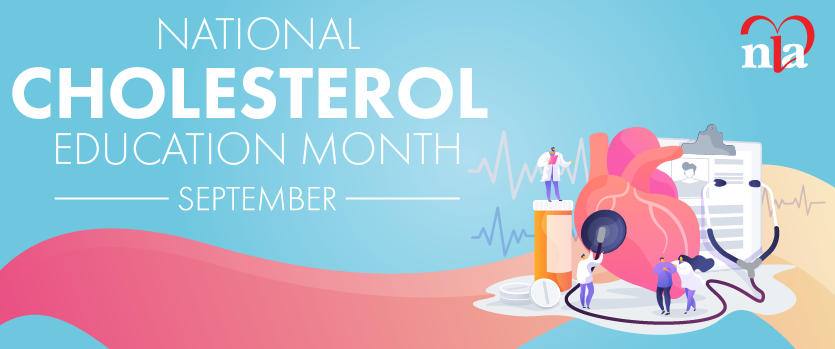We present a clinical case and offer Practical Pearls from primary care/Lipid Specialist and cardiology for management of a common scenario, reinforcing the importance of a clinician-patient discussion.
Key points:
- Severe hypercholesterolemia (LDL-C ≥ 190 mg/dL)
- is a high-risk condition
- warrants high-intensity statin
- warrants outreach to family members (cascade screening) to test their lipid profile (+/- FH genotyping) and Lp(a)
- ASCVD risk is higher in individuals with LDL-C > 190 mg/dL and the presence of high CACS, high Lp(a), and/or putative genotype associated with monogenic familial hypercholesterolemia (FH).
- A clinician-patient discussion is critical to optimize care for the individual.
- A team-based approach can improve adherence to recommended therapy when the team reinforces each other's message.
- NLA resources enable optimal management including the 2018 AHA/ACC Multisociety Guideline on the Management of Blood Cholesterol, Patient Tear Sheets, Position Statements on Lp(a) and Genetics
Case For Discussion
History: Carl is a 41-year-old man of European descent who presents for annual health assessment. He is married and has two teenage children. He works in sales. He feels well and voices no complaints. He does have seasonal allergies but takes no medications or dietary supplements. He has a history of “high cholesterol” and is medication (especially statin) averse.
He runs 2-3 miles five days a week without difficulty. He has never smoked and consumes “a few beers” on the weekend. He describes a busy work schedule, with long hours traveling for business. He eats fast food regularly. There is no history of heart disease in his family. His father is in good health at 75 years old. His mother died in her 50s from colon cancer. He does not know anything about their cholesterol levels. He has no siblings.
Examination: Office blood pressure 153/98 mmHg left brachial (using the average of 3 readings of a digital apparatus); Weight 284 lbs; Height 6’2”; Waist Circumference 38”; Calculated Body Mass Index 36. There are no xanthomata or xanthelasma. There is no corneal arcus. The carotids are palpable with no audible bruit. The lungs are clear to auscultation. The heart is regular with no murmur, gallop, click, or rub. The abdominal exam reveals no mass, hepatosplenomegaly, or audible bruit. The pedal pulses are strong and palpable.
Laboratory Studies (Fasting): Total Cholesterol (TC) 321 mg/dL; Triglycerides (TG) 149 mg/dL; high density lipoprotein cholesterol (HDL-C) 36 mg/dL; low density lipoprotein cholesterol (LDL-C) 255 mg/dL; nonHDL-C 285 mg/dL; thyroid stimulating hormone (TSH) 1.39 mU/L; Glucose 80 mg/dL; AST/ALT normal. Urinalysis is normal. This lipid profile is similar to previous.
EKG is normal.
Assessment
Primary Care Perspective: Carl appears to have high short- and longterm cardiovascular risk based upon persistent LDL-C greater than 190 mg/ dL. After confirming that he has availed himself of dietary advice, including consultation with a registered dietitian, the LDL-C has not responded enough and remains >190 mg/dL supporting the need for pharmacotherapy. The 2018 AHA/ACC/Multisociety Guidelines on the Management of Blood Cholesterol (1) affirm the recommendation for highintensity statin therapy as a class IA recommendation in adults with LDL-C ≥ 190 mg/dL. The Guidelines also make the point that additional risk assessment with the pooled cohort risk equation (PCE) is not reliable enough and is not needed in individuals with LDL-C ≥190 mg/dL to endorse the statin recommendation.
In fact, he may have Heterozygous Familial Hypercholesterolemia (HeFH) which has additional clinical implications. The diagnosis is suspected because of the lipid phenotype, but he does not have other features (physical examination sequelae, family history high cholesterol or premature ASCVD, and he has not had genotyping performed). Although there is no reported family history, there is minimal family information and his mother died at a young enough age that the condition may not have manifested yet.
Based upon the patient’s reluctance to start on statin therapy, further risk stratification with coronary artery calcium scoring (CACS) by computed tomography (CT) was recommended. In addition, we refocused efforts at lifestyle modification and BP attention, reinforced by recommendations from the 2019 ACC/ AHA Guideline on the Primary Prevention of Cardiovascular Disease.(2)
It was clear that a heavy-handed prescription was not going to persuade Carl. I told him that I was concerned about his health and cardiovascular risk and stressed the importance of optimal care for him as a father to young children. I told him to expect multiple visits and interactions over the next year as we focused on his care, his risk assessment, and response to therapy. He was open to learning more and found it helpful to review NLA tear sheets (https://www. lipid.org/Patient%20Tear%20Sheets%20 %28updated%29) on “Coronary Artery Calcium Testing,” “Heart Healthy Eating,” and the “Mediterranean Diet.”
Cardiology Perspective: Carl has features of Heterozygous Familial Hypercholesterolemia (HeFH). Additional risk stratification is not recommended by the 2018 Guidelines (1) as a decision tool for prescription of statin therapy, but CACS has been demonstrated to have the ability to stratify risk amongst individuals with LDL-C ≥190 mg/dL in the Multiethnic Study of Atherosclerosis (MESA) and may persuade Carl about the role of statins as well.(3) I completely agree with Dr. White’s recommendation to attend to lifestyle changes and better BP control. In addition to home monitoring, a 24-hour ambulatory blood pressure monitor may be considered.
Furthermore, the ongoing communication between clinicians and the patient is critical, and my role as the specialist can reinforce the recommendations from the primary clinician. I do find that the conversation can be extended by sharing written information and my office is decorated with informational pieces including CardioSmart Posters (CardioSmart.org/Posters) on different topics including hypertension, such as “Know Your Numbers” and “Active and Mindful Living.” Patients have time to digest this information before they see me for their visit and we can then review details when we are face-to-face. I have NLA brochures as well as heart models to describe what long term hypercholesterolemia can do to arterial health and function and the hands-on description is always appreciated by patients.
Outcome
We were able to help Carl overcome his concerns about radiation exposure and cost for the CT scan, and he was found to have CACS = 737 (a categorically high reading and greater than the 99th percentile for age/gender/ethnicity per MESA calculator [https://www.mesa-nhlbi.org/Calcium/ input.aspx]).
Fortunately, Carl has made significant therapeutic lifestyle changes (TLC) supported by dietary changes for his entire family. In addition, home BP monitoring confirms very good control (110-130/60-70 mmHg range using a digital apparatus). He has continued to exercise and still feels well. While low yield, exercise testing is indicated when CACS > 400 and is an indication for both statin and aspirin therapy based upon expert consensus conclusions.(4,5)
After additional discussion regarding risks, benefits, evidence, cost, and expectations of high intensity statin and aspirin therapies, he was willing to initiate both. He is reassured that I will listen and seek solutions should any potential side effects develop. He is again encouraged to communicate his questions and results electronically on a regular basis for now.
Next Steps
Primary Care Perspective: In addition to the initial acceptance of high intensity statin, long-term adherence and appropriately timed monitoring, reinforcement of ongoing need, and add-on therapy to optimize outcome is critical. Adherence to statin therapy wanes over time even in the highest risk patients (6) and a long-term open relationship is necessary to optimize adherence. The ease of access and electronic communication, not to mention the impression made by the CAC score, will hopefully enhance this process.
Over time, it may be necessary to consider additional lipid-lowering therapy, such as ezetimibe, PCSK9 inhibitor or bempedoic acid.
Additional testing to further stratify his risk and inform decision-making in his family include testing lipoprotein(a) and genetic testing for variants associated with HeFH.(7,8)
Cardiology Perspective: I encourage an exercise treadmill test for CACS >400 in accordance with 2010 Multisociety guidelines, though acknowledge that the yield is low in individuals who can exercise without cardiorespiratory limitations.(9)
Conclusions: This case illustrates many of the challenges we face as clinicians and clinical lipid specialists: caring for healthyappearing, asymptomatic patients who may be at higher cardiovascular risk than realized, patients who are reluctant to begin pharmacotherapy (especially statin therapy!), the pros and cons of “Internet Medicine”, the limitations of a “negative” family history, the use and benefits of atherosclerosis imaging/CACS, and the value of shared decision-making and a team approach.
Disclosure statement:
Dr. White has received honoraria from Amarin, Ionis, and Johnson & Johnson. Dr. Patel has received honoraria from Novartis, Jansen and Jansen, Bochringer Ingelheim, Amgen, Amarin, and AstraZeneca.
References:
1. Grundy SM, Stone NJ, Bailey AL, et al. 2018 AHA/ACC/AACVPR/ AAPA/ABC/ACPM/ADA/AGS/APhA/ASPC/NLA/PCNA Guideline on the Management of Blood Cholesterol: A Report of the American College of Cardiology/American Heart Association Task Force on Clinical Practice Guidelines. Circulation. 2019. doi:10.1161/ CIR.0000000000000625
2. Arnett DK, Blumenthal RS, Albert MA, et al. 2019 ACC/AHA Guideline on the Primary Prevention of Cardiovascular Disease: Executive Summary. J Am Coll Cardiol. 2019. doi:10.1016/j. jacc.2019.03.009
3. Sandesara PB, Mehta A, O’Neal WT, et al. Clinical significance of zero coronary artery calcium in individuals with LDL cholesterol ≥190 mg/dL: The Multi-Ethnic Study of Atherosclerosis. Atherosclerosis. 2020;292:224-229. doi:10.1016/j. atherosclerosis.2019.09.014
4. Miedema MD, Duprez DA, Misialek JR, et al. Use of coronary artery calcium testing to guide aspirin utilization for primary prevention: estimates from the multi-ethnic study of atherosclerosis. Circ Cardiovasc Qual Outcomes. 2014;7(3):453-460. doi:10.1161/ CIRCOUTCOMES.113.000690
5. Hecht H, Blaha MJ, Berman DS, et al. Clinical indications for coronary artery calcium scoring in asymptomatic patients: Expert consensus statement from the Society of Cardiovascular Computed Tomography. J Cardiovasc Comput Tomogr. 2017;11(2):157-168. doi:10.1016/j.jcct.2017.02.010
6. Colantonio LD, Huang L, Monda KL, et al. Adherence to HighIntensity Statins Following a Myocardial Infarction Hospitalization Among Medicare Beneficiaries. JAMA Cardiol. 2017;2(8):890-895. doi:10.1001/jamacardio.2017.091
7. Wilson DP, Jacobson TA, Jones PH, et al. Use of Lipoprotein(a) in clinical practice: A biomarker whose time has come. A scientific statement from the National Lipid Association. J Clin Lipidol. 2019;13(3):374-392. doi:10.1016/j.jacl.2019.04.010
8. Brown EE, Sturm AC, Cuchel M, et al. Genetic testing in dyslipidemia: A scientific statement from the National Lipid Association. J Clin Lipidol. 2020. doi:https://doi.org/10.1016/j. jacl.2020.04.011
9. Greenland P, Alpert JS, Beller GA, et al. 2010 ACCF/AHA Guideline for Assessment of Cardiovascular Risk in Asymptomatic Adults: A Report of the American College of Cardiology Foundation/ American Heart Association Task Force on Practice Guidelines Developed in Collaboration With the American Socie. J Am Coll Cardiol. 2010;56(25):e50-e103. doi:https://doi.org/10.1016/j. jacc.2010.09.001





.jpg)
.png)












